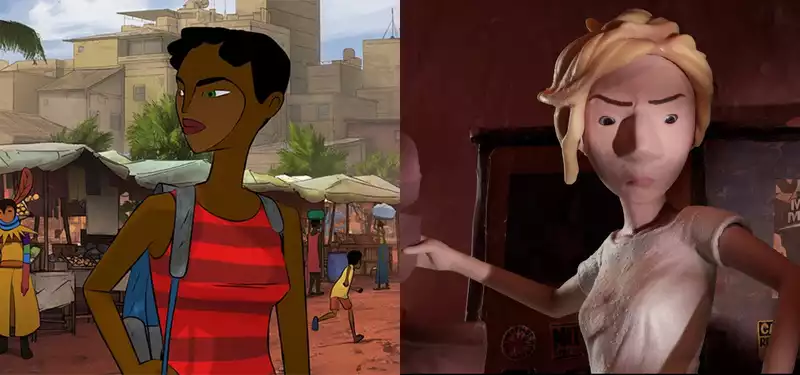Jun 21, 2022
Two animated feature films from Portugal: "Nayola" and "My Grandfather's Demons
The Annecy International Animated Film Festival kicked off last week with a triumphant closing ceremony on Saturday evening.
This year's festival, the first fully direct festival since 2019, boasted a competition lineup that is surely one of the strongest the festival has ever offered.
Stories of the past resonating strongly in the present led two Portuguese films premiering in Annecy's Official Selection (one in the main competition, the other in the festival's quirky contrarian lineup): Nayola and My Grandfather's Demons". The presence of these two films in the competition foreshadows the near future of animation production on the Iberian Peninsula. (On June 18, "Nayola" won the Best Animated Feature Award at the Guadalajara International Film Festival, where it was also screened last week.)
The historical drama "Nayola" is set in Angola, a country in southwest Africa that was a Portuguese colony, and depicts the generational scars derived from the not-so-distant armed conflict between 1995 and 2011. Based on a screenplay by Virgilio Almeida, who adapted the stage play The Black Box by José Eduardo Aguiarza and Mia Couto, director José Miguel Ribeiro has constructed a rich and powerful allegory about letting go.
In the mid-1990s, as civil war rages, young mother Nayola (Elisangela Rita) desperately searches for her husband. The narration begins to tell us of her distraught feelings. Nayola's teenage daughter Yara (Feliciana Delsia Guia) rebels against the authoritarian government and distributes political rap songs as CDs throughout Luanda.
Ribeiro uses a stylized, hand-drawn aesthetic to create a gorgeously dreamlike interpretation of the inner turmoil faced by his heroine. There is a clear difference between Nayola's experience in a time of relative peace and Yara's depiction of her tribulations.
Scenes that occur in Nayola's memory, especially those relating to her missing loved ones, are depicted in a manner reminiscent of the French title, The Girl Without Hands. Yet even when she is not remembering precisely, the background of her timeline is awash in saturated colors and surrealist production design. Ribeiro and Almeida are cool-headed about violence, especially in scenes of starving people fighting each other over food delivered by the United Nations. The adaptable and wise jackal of African folklore not only follows in her footsteps here, but ultimately becomes a symbol of her tireless efforts to survive and achieve her goals. The focus of the film, however, is Nayora's inability to cleanse herself from the horrors she has witnessed. Overwhelmed by grief, she loses herself.
In 2011, Yara and her grandmother, Relena (Vitoria Adelino Diaz Soares), receive an unexpected visit from a mysterious robber. The more Nayora's past is unraveled, the more the distance between the two parallel timelines shrinks. Solemn in tone, yet vividly fatuous in its treatment of serious themes, the film also folds in small-touch documentary footage set to an impressive song, providing further visual information about the events that transpired.
Ribeiro's impressive work of historical fiction advances in similar thematic territory and evocative handiwork to the recent GKIDS domestic release of "Funan" and "Another Day of Life." It is not far-fetched to assume that Nayora will be released by GKIDS in North America as well.
Although somewhat less poignant, Nuno Beato's "Grandfather's Devil," which uses this media technique, opens in a demanding office environment where employees must constantly improve their performance. At the pinnacle of productivity is Rosa (Victoria Guerra), a young woman on the road to success.
The digital animation in the early part of the first act deliberately omits details to match the efficiency-oriented mood of the big city, creating a rational, cold impression. Her monotonous, work-obsessed lifestyle begins to consume her, evoking a desire to be reunited with her aging grandfather Marcelino (Antonio Durániz). A montage of her youth is shown with her grandfather's narration, and at the end Rosa learns that he has passed away.
Shocked, she drives back to her hometown to clean out her grandfather's house and sell it. The moment Rosa arrives on the outskirts of the small community, the generic CG images are transformed into the tactile and magical realm of stop-motion. Though obvious, this tangible transition from a capitalist reality to a rustic, handcrafted one demonstrates the director's smart vision of applying both alternatives for dramatic ends.
The imperfect puppets seem closer to Will Vinton's claymation work than to the more sophisticated creations of McKinnon & Saunders or Laika. Similarly, the sets have traces of human handiwork that is not always accurate. With a color palette that is predominantly ochre and brown and a convincingly irregular texture to the terrain, the production design reflects how long the land has been deprived of water.
Upon taking up residence, Rosa begins to learn of her grandfather's disdain for those around him, especially Antonio (Celso Bugallo), who was once his best friend. While Marcelino's narration provides the details, Rosa learns her grandfather's secret in a strange nightmare inhabited by demonic creatures made of clay that he created to represent himself and others. The recurring appearance of these beings, life-size on bookshelves or in her shimmering visions, gives the picture an otherworldly feel. They are not scary, but they are effective in conveying the burden beyond the grave that torments Marcelino.
Despite the temptation to leave it all behind, Rosa decides to stay and figure out how to bring water back to the local river and right his wrongs. As a result, Rosa learns to detach from the mental unfulfillment that had previously overwhelmed her.
Beato's condemnation of Marcelino's actions resonates more harshly than might be expected in a relatively family-friendly feature, but that is what gives the story meaningful gravitas. Fueled by illogical envy and hatred, the old man not only shuts everyone out, but actively pursues their suffering. And even if, in the end, the resolution hinges on a few convenient revelations and other unsolved family mysteries, there is a self-earned catharsis.
.



Post your comment